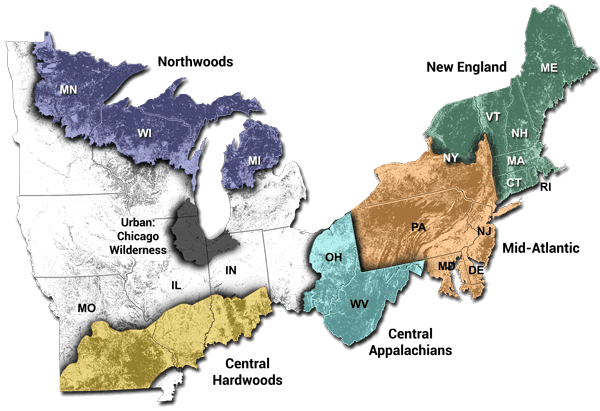Climate Change Atlas Products
There are numerous products from the Climate Change Atlas in addition to the Tree and Bird Atlases.
Publications
Combined Species Outputs
Summaries for tree species are available for a variety of geographies, in both PDF and Excel format. These summaries are based on Version 4 of the Climate Change Tree Atlas
Regional Assessments
Several climate change vulnerability assessments have been developed through the Climate Change Response Framework. The Framework is a collaborative, cross-boundary approach among scientists, managers, and landowners to incorporate climate change considerations into natural resource management. It provides an integrated set of tools, partnerships, and actions to support climate-informed conservation and forest management.
The following tables are Climate Change Tree Atlas outputs from assessments, which provide information to better understand the vulnerability of tree species to climate change in their particular region. Five regional assessments have been published across the Central Appalachians, Central Hardwoods, and Northwoods regions (Michigan, Minnesota, and northern Wisconsin and Upper Michigan), the Mid-Atlantic, New England and Northern New York, and Chicago areas.

The assessment output tables are somewhat complicated, by necessity. In addition to providing the numerical values for the current and projected suitable habitat of tree species from the DISTRIB model, tree species are also assigned to one of seven “Changes Classes” for each of the PCM B1 and GFDL A1FI climate scenarios. These classes are on the ratio of future habitat in 2100 to current habitat from the DISTRIB models:
- Extirpated (Complete loss of habitat in future)
- Large decrease (Future:Current ratio <0.5)
- Small decrease (Future:Current ratio >0.5 & <0.8)
- No change (Future:Current ratio >0.8 & <1.2)
- Small increase (Future:Current ratio >1.2 & <2)
- Large increase (Future:Current ratio >2)
- New habitat: Suitable habitat is present in the future (currently does not exist)
We also provide the Modifying Factors information for each species to be evaluated in tandem with the potential changes in suitable habitat. These are based on 9 biological and 12 disturbance factors (PDF - Also available in Excel format) not modeled in the DISTRIB models, which lead to an Adapt score related to the adaptability of the species to climate change.
To interpret the vulnerability of a species to climate change, consider the Change Class designations for the two scenarios together with the Modifying Factors and Adapt score – combined, these indicators provide the best perspectives on how the species habitat may change across the region. To better interpret them, we provide information on Interpreting Regional Assessment Tables (PDF).
Please review publications to further understand the process; you can also contact the Atlas team for further clarification if desired.
Vulnerability Assessment Tables for Potential Changes in Suitable Habitat for Trees
More Information
For more information, visit the Climate Change Response Framework website
National Climate Assessments
This work has been used for the National Climate Assessment, including the Forestry Sector and the Midwest Region reports. A General Technical Report has been published related to the Forest Sector Technical Report, used as input to the final National Climate Assessment. In it, we use the DISTRIB and Modification Factor outputs to derived risk matrices related to vulnerability of suitable habitat for species.

